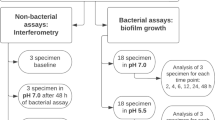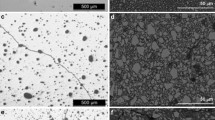Abstract
In the present study, two different fibre-reinforced composites (FRCs) (glass and polyethylene FRC), dental ceramic and restorative composite were compared with respect to early plaque formation in vivo. Disc-shaped specimens were randomly distributed among the upper first and second molars of 14 healthy adult volunteers. Plaque samples were collected 24 h after the attachment of the specimens. Mutans streptococci (MS), non-mutans streptococci and total facultative bacteria were cultured. The plaque recovered from polyethylene FRC harboured significantly more MS than the plaque of ceramic, restorative composite and glass FRC. For the counts of non-mutans streptococci and total facultative bacteria, polyethylene FRC showed the highest counts, and ceramic showed a trend towards lower counts. The amount of plaque accumulation showed an association to the earlier reported surface roughness values of the studied materials. It was concluded that in the oral environment, polyethylene FRC promotes plaque accumulation and adhesion of MS more than glass FRC, restorative composite and dental ceramic. Glass FRC resembles restorative composite with respect to plaque accumulation and the adherence of MS.





Similar content being viewed by others
References
Banas J, Russell R, Ferretti J (1990) Sequence analysis of the gene for the glucan-binding protein Streptococcus mutans Ingbritt. Infect Immun 58:667–673
Carlén A, Borjesson A, Nikdel K, Olsson J (1998) Composition of pellicles formed in vivo on tooth surfaces in different parts of the dentition, and in vitro on hydroxyapatite. Caries Res 36:447–455
Carlén A, Bratt P, Stenudd C, Olsson J, Strömberg N (1998) Agglutinin and acidic proline-rich protein receptor patterns may modulate bacterial adherence and colonization on tooth surfaces. J Dent Res 77:81–90
Carlén A, Nikdel K, Wennerberg A, Holmberg K, Olsson J (2001) Surface characteristics and in vitro biofilm formation on glass ionomer and composite resin. Biomaterials 22:481–487
Carlén A, Olsson J (1995) Monoclonal antibodies against a high-molecular-weight agglutinin block adherence to experimental pellicles on hydroxyapatite and aggregation of Streptococcus mutans. J Dent Res 74:1040–1047
Carlen A, Olsson J, Borjesson AC (1996) Saliva-mediated binding in vitro and prevalence in vivo of Streptococcus mutans. Arch Oral Biol 41:35–39
Carlén A, Olsson J, Ramberg P (1996) Saliva mediated adherence, aggregation and prevalence in dental plaque of Stretococcus mutans, Streptococcus sanguis and Actinomyces spp, in young and elderly humans. Arch Oral Biol 41:1133–1140
Fujiwara T, Sasada E, Mima N, Ooshima T (1991) Caries prevalence and salivary mutans streptococci in 0–2-year old children in Japan. Community Dent Oral Epidemiol 19:151–154
Gahnberg L, Olsson J, Krasse B, Carlén A (1982) Interference of salivary immunoglobulin A antibodies and other salivary fractions with adherence of Streptococcus mutans to hydroxyapatite. Infect Immun 37:401–406
Gibbons R, Hay D (1988) Human salivary acidic proline-rich proteins and statherin promote the attachment of Actinomyces viscosus LY7 to apatitic surfaces. Infect Immun 56:439–445
Gibbons R, Hay D (1989) Adsorbed salivary acidic proline-rich proteins contribute to the adhesion of Streptococcus mutans JBP to apatitic surfaces. J Dent Res 68:1303–1307
Gold O, Jordan H, van Houte J (1973) A selective medium for Streptococcus mutans. Arch Oral Biol 18:1357–1364
Leonhardt A, Olsson J, Dahlen G (1995) Bacterial colonization on titanium, hydroxyapatite, and amalgam surfaces in vivo. J Dent Res 74:1607–1612
Nyvad B, Fejerskov O (1987) Transmission electron microscopy of early microbial colonization of human enamel and root surfaces in vivo. Scand J Dent Res 95:297–307
Nyvad B, Kilian M (1987) Microbiology of the early colonization of human enamel and root surfaces in vivo. Scand J Dent Res 95:369–380
Nyvad B, Kilian M (1990) Comparison of the initial streptococcal microflora on dental enamel in caries-active and in caries-inactive individuals. Caries Res 24:267–272
Quirynen M, Bollen CML (1995) The influence of surface roughness and surface-free energy on supra- and subgingival plaque formation in man. A review of the literature. J Clin Periodontol 22:1–14
Siegrist BE, Brecx MC, Gusberti FA, Joss A, Lang NP (1991) In vivo early human dental plaque formation on different supporting substances. A scanning electron microscopic and bacteriological study. Clin Oral Implants Res 2:38–46
Söderling E, Isokangas P, Pienihäkkinen K, Tenovuo J (2000) Influence of maternal xylitol consumption on acquisition of mutans streptococci by infants. J Dent Res 79:882–887
Tanner J, Carlén A, Söderling E, Vallittu P (2003) Adsorption of parotid saliva proteins and adhesion of Streptococcus mutans ATCC 25175 to dental fiber-reinforced composites. J Biomed Mater Res 66B:391–398
Theilade E, Theilade J, Mikkelsen L (1982) Microbiological studies on early dento-gingival plaque on teeth and Mylar strips in humans. J Periodontal Res 17:12–25
Weerkamp A, Quirynen M, Marechal M, Van der Mei H, van Steenberghe D, Busscher H (1989) The role of surface free energy in the early in vivo formation of dental plaque on human enamel and polymeric substrata. Microb Ecol Health Dis 2:11–18
Whiley RA, Beighton D (1998) Current classification of the oral streptococci. Oral Microbiol Immunol 13:195–216
Wood SR, Kirkham J, Marsh PD, Shore RC, Nattress B, Robinson C (2000) Architecture of intact natural human plaque biofilms studied by confocal laser scanning microscopy. J Dent Res 79:21–27
Author information
Authors and Affiliations
Corresponding author
Rights and permissions
About this article
Cite this article
Tanner, J., Robinson, C., Söderling, E. et al. Early plaque formation on fibre-reinforced composites in vivo. Clin Oral Invest 9, 154–160 (2005). https://doi.org/10.1007/s00784-005-0317-4
Received:
Accepted:
Published:
Issue Date:
DOI: https://doi.org/10.1007/s00784-005-0317-4




